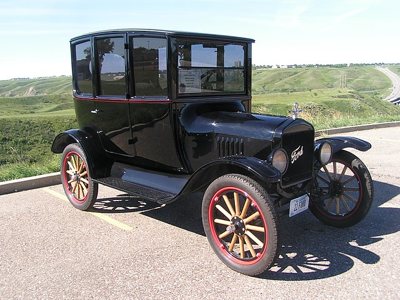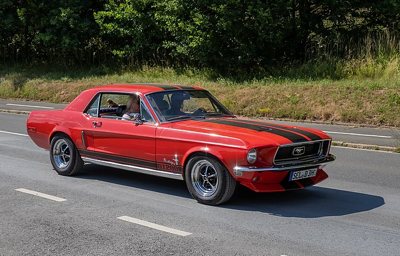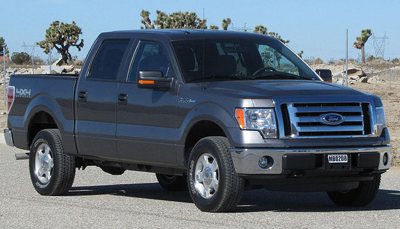In 1903, Henry Ford established the Ford Motor Company in Detroit, Michigan, with a total of $28,000 in cash from twelve investors. The company's first vehicle, the Model A (1903-1904), was introduced shortly after. However, it was the release of the Ford Model T in 1908 that catapulted the company to leadership in the automotive industry.
Who Owns Ford?
The Ford Motor Company is not owned by any single individual. It is a publicly traded company, so it is owned by its shareholders.
The Ford family still retains unique influence over the company through their ownership of Class B shares. Their Class B shares actually accounts for only 2% of the total shares but they carry 40% of the voting power. It has been structured this way to ensure the family maintains control over key decisions. Bill Ford, Henry Ford's great-grandson, is the largest individual shareholder and serves as the company's Executive Chairman.
Ford Model T - Pushing The Boundaries Of Manufacturing
 Ford's success in the automotive industry was cemented with the release of the Model T - an economy vehicle made for the masses. On its release, the Model T was only $850 and consumers easily chose this vehicle as others were priced for at least $2,000. Thanks to its assembly line method of manufacturing and other production cost cutting methods it became the Number 1 choice for many early drivers.
Ford's success in the automotive industry was cemented with the release of the Model T - an economy vehicle made for the masses. On its release, the Model T was only $850 and consumers easily chose this vehicle as others were priced for at least $2,000. Thanks to its assembly line method of manufacturing and other production cost cutting methods it became the Number 1 choice for many early drivers.
Under the hood, the Ford Model T was powered by a 2.9L I4 engine with only 20 horsepower and top speed of only 45 mph. The car was 134 inches long and 66 inches wide. Because of its success, Ford Model T went through different upgrades and revisions until 1927.
Ford Mustang - The Muscle Car of the 60s
 For those looking for power under the hood, the Ford Mustang is up to the challenge, a legacy that began with its introduction in 1964. Considered as one of the classic "Pony Cars", this highly stylized vehicle was unmistakable on the road with its long hood accommodating a massive engine and short rear deck that typically seats two passengers.
For those looking for power under the hood, the Ford Mustang is up to the challenge, a legacy that began with its introduction in 1964. Considered as one of the classic "Pony Cars", this highly stylized vehicle was unmistakable on the road with its long hood accommodating a massive engine and short rear deck that typically seats two passengers.
Already in its 7th generation, the latest Mustang still features the same body type but with modern flair. Its most powerful model is the 2025 edition featuring the 5.2 L Predator Supercharged V8 (GTD) engine with top speed of up to 202 mph and 0-60 mph acceleration of only 3.5 seconds. The latest model is 189.4 inches long and 75.4 inches wide.
Ford Bronco - An Off Road SUV from the 60s
 The Ford Bronco was first introduced in 1966 to compete with other off-road vehicles of its time. Despite being an SUV, the Bronco has undergone several design changes.
The Ford Bronco was first introduced in 1966 to compete with other off-road vehicles of its time. Despite being an SUV, the Bronco has undergone several design changes.
It was initially offered in 3 body styles - the "Wagon" (SUV), the "Roadster" (roofless), and the "Sports Utility Pickup" (half-cab).
Although the Bronco was temporarily discontinued in 1996 due to low sales, the Ford Bronco was reintroduced in 2021. The latest Broncos are available in two-door and four-door versions with three engine options. Its most powerful engine is the 3.0 L EcoBoost V6 Twin-Turbo with top speed of up to 110 mph. The two-door version is measured at 174.8 inches long while the four-door version is up to 190.5 inches long. Both versions are up to 79.3 inches wide.
Ford F-Series - The King of Pick-up Trucks
In 2024, the best-selling vehicles in the US were trucks and SUVs and the Ford F-Series emerged the undisputed leader. Offering rugged performance with comfort for drivers, it's the perfect vehicle for those looking for a nice ride even on the most challenging road. The F-Series was first introduced in 1948 and initially offered models for personal and commercial use.
 Among the different models of F-Series, the F-150 is the most popular. Introduced in 1975 as the upgraded version of F-100, the vehicle became an instant success because of its higher payload capacity. Its base version came with 4.9L - I6 engine with 113 horsepower and loading capacity of more than 6,000 lbs. It also came with a large storage area and customers could opt for a larger cab version (SuperCab) that sat up to six passengers. The first F-150 was 209.1 inches (regular cab) to 248.9 inches (crew cab) long depending on the cab configuration and 79 inches wide.
Among the different models of F-Series, the F-150 is the most popular. Introduced in 1975 as the upgraded version of F-100, the vehicle became an instant success because of its higher payload capacity. Its base version came with 4.9L - I6 engine with 113 horsepower and loading capacity of more than 6,000 lbs. It also came with a large storage area and customers could opt for a larger cab version (SuperCab) that sat up to six passengers. The first F-150 was 209.1 inches (regular cab) to 248.9 inches (crew cab) long depending on the cab configuration and 79 inches wide.
Today's F-150 continues the long tradition of powerful trucks that offers rugged performance but with additional EV options for customers looking for a more green option on their pick-ups. In 2021, the first hybrid was introduced with up to 430 horsepower and a full EV was added to the F-150 line in 2022 that offers up to 320 mile range on a single charge with top speed of 107 mph. The latest version of F-150 is 231.7 inches long and 79.9 inches wide. This popular truck also features some of the best tech for pick-up trucks such as a 12-inch screen with heads-up display, infotainment system with fast integration to mobile devices as well as Pro Power Onboard which transforms the F-150 as a power generator.
The Size Evolution Of The Ford F-150
The Ford F-150 has evolved significantly in size and models since its first introduction in 1975. Let's take a quick look at the journey:
- 1975 (First F-150): Length ranged from 209.1 inches (regular cab) to 248.9 inches (crew cab), with a width of 79 inches. It had a payload capacity of over 6,000 lbs.
- 2004 (11th Generation): Remodeled with a stronger frame, the lengths ranged from 211.2 inches to 248.3 inches, and width increased to 78.9 inches.
- 2015 (13th Generation): Introduced aluminum construction so there was a reduction in weight. Lengths ranged from 209.3 inches to 250.5 inches, with a width of 79.9 inches.
- 2022 (F-150 Lightning): Fully electric model. Measured 231.7 inches in length and had a width of 79.9 inches, offering a range of up to 320 miles.
- 2025 (Latest Model): Lengths range from 231.7 inches to 250 inches, depending on the configuration, with a width of 79.9 inches.
In summary, the F-150 has grown in size and capability. It has also been adapted to modern needs without losing its reputation for rugged performance.
Ford's vision for the future is centered on creating innovative, eco-friendly vehicles that will meet diverse consumer needs while pushing the boundaries of technology.
